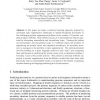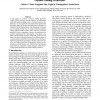188 search results - page 24 / 38 » Improving protein secondary structure prediction using a sim... |
ISMIS
2005
Springer
14 years 1 months ago
2005
Springer
In this paper, we adapt a statistical learning approach, inspired by automated topic segmentation techniques in speech-recognized documents to the challenging protein segmentation ...
BMCBI
2010
13 years 7 months ago
2010
Background: It is well known that most of the binding free energy of protein interaction is contributed by a few key hot spot residues. These residues are crucial for understandin...
FLAIRS
2008
13 years 9 months ago
2008
1 In this paper, we propose a peptide folding prediction method which discovers contrast patterns to differentiate and predict peptide folding classes. A contrast pattern is defin...
BMCBI
2008
13 years 7 months ago
2008
Background: Prediction of transmembrane (TM) helices by statistical methods suffers from lack of sufficient training data. Current best methods use hundreds or even thousands of f...
BMCBI
2006
13 years 7 months ago
2006
Background: Predicting residues' contacts using primary amino acid sequence alone is an important task that can guide 3D structure modeling and can verify the quality of the ...


